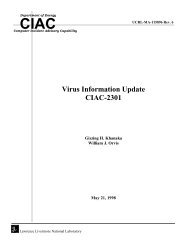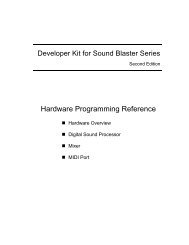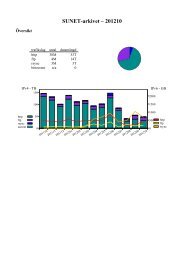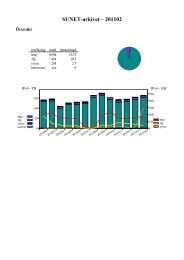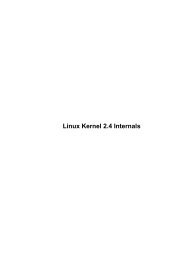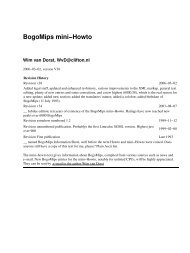Linux IP Masquerade HOWTO - The Linux Documentation Project
Linux IP Masquerade HOWTO - The Linux Documentation Project
Linux IP Masquerade HOWTO - The Linux Documentation Project
You also want an ePaper? Increase the reach of your titles
YUMPU automatically turns print PDFs into web optimized ePapers that Google loves.
Chapter 2. Background Knowledge<br />
2.1. What is <strong>IP</strong> <strong>Masquerade</strong>?<br />
<strong>IP</strong> <strong>Masquerade</strong> is a networking function in <strong>Linux</strong> similar to the one−to−many (1:Many) NAT (Network<br />
Address Translation) servers found in many commercial firewalls and network routers. For example, if a<br />
<strong>Linux</strong> host is connected to the Internet via PPP, Ethernet, etc., the <strong>IP</strong> <strong>Masquerade</strong> feature allows other<br />
"internal" computers connected to this <strong>Linux</strong> box (via PPP, Ethernet, etc.) to also reach the Internet as well.<br />
<strong>Linux</strong> <strong>IP</strong> Masquerading allows for this functionality even though these internal machines don't have an<br />
officially assigned <strong>IP</strong> address.<br />
MASQ allows a set of machines to invisibly access the Internet via the MASQ gateway. To other machines on<br />
the Internet, the outgoing traffic will appear to be from the <strong>IP</strong> MASQ <strong>Linux</strong> server itself. In addition to the<br />
added functionality, <strong>IP</strong> <strong>Masquerade</strong> provides the foundation to create a HEAVILY secured networking<br />
environment. With a well built firewall, breaking the security of a well configured masquerading system and<br />
internal LAN should be considerably difficult to accomplish.<br />
If you would like to know more on how MASQ (1:Many) differs from 1:1 (true) NAT and Proxy solutions,<br />
please see the Section 7.6 FAQ entry.<br />
2.2. Current Status<br />
<strong>IP</strong> <strong>Masquerade</strong> has been in the <strong>Linux</strong> kernels for several years now and is quite mature as the kernel enters the<br />
2.4.x stage. Kernels since <strong>Linux</strong> 1.3.x have had MASQ support built−in. Today, many individuals and<br />
commercial businesses are using it with excellent results.<br />
2.4.x kernel users:<br />
• <strong>The</strong> 2.4.x kernel hosts an entirely re−written set of NAT code which is both far superior, faster, and<br />
more secure than any previous versions written for <strong>Linux</strong>. Unfortunately, several kernel modules that<br />
were written for the 2.2.x kernel to support things like UDP−based RealAudio, etc. have not been<br />
ported to 2.4.x yet. Because of this, some people should consider NOT upgrading if these network<br />
applications are critical to them. But, at the same time, some of these programs have been updated and<br />
now use different, NAT−friendly protocols. Thus special NAT treatment is no longer required. As<br />
always, please see the http://ipmasq.webhop.net/: <strong>The</strong> <strong>IP</strong> <strong>Masquerade</strong> Resources site for updated<br />
news, etc.<br />
Common network functionalities like Web browsing, telnet, ssh, ping, traceroute, etc. work well over stock <strong>IP</strong><br />
<strong>Masquerade</strong> setups. Other network applications such as ftp, irc, and Real Audio work well with the<br />
appropriate additional <strong>IP</strong> MASQ modules loaded into the kernel as modules. Other network−specific<br />
programs like streaming audio (MP3s, True Speech, etc) should work too without any special module. Some<br />
users on the mailing list also had good results with video conferencing software.<br />
It should be noted that running <strong>IP</strong> <strong>Masquerade</strong> with only ONE network card (NIC) to MASQ between internal<br />
and external Ethernet networks is NOT recommended. For more details, please see Section 7.28 FAQ section.<br />
Anyways, please refer to Section 6.3 for a more complete listing of software supported by <strong>IP</strong> Maquerade all<br />
kernel versions.<br />
Chapter 2. Background Knowledge 3





